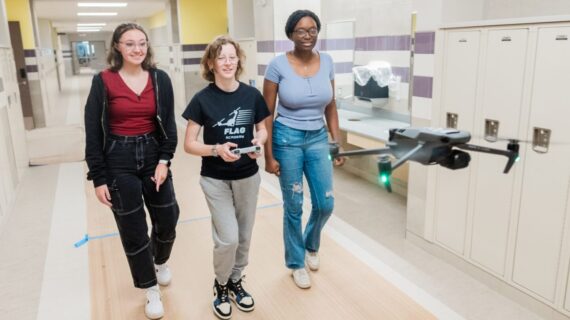
Making learning matter in the Greater Latrobe School District
This story is one in a series created in collaboration with the AASA Learning 2025 Alliance to celebrate the work of groundbreaking school districts in the Pittsburgh region. Kidsburgh will share these stories throughout 2024.
In Greater Latrobe, even the course catalog sparks students’ interests.
Instead of electives like music and art, students choose from classes called “Law and Order” and “Pumpkin Drop.” There’s a “Newsies” course for students interested in journalism and graphic design. There’s a “Shark Tank” course for budding entrepreneurs. There’s even an art class focused on Hispanic foods and culture.
“And I’ll tell you what,” says Becki Pellis, Greater Latrobe’s assistant superintendent for elementary education: “The enchiladas they make are phenomenal.”
The electives — each of which combine two or more subject areas — are part of a larger shift underway across the Greater Latrobe School District: one designed to make learning more rigorous, more relevant, and more engaging for students and teachers alike. What was once a health class, for example, becomes “Medical Detectives,” drawing on a science teacher’s background as an emergency medical technician. A nearby airport becomes a potential workplace, thanks to the “Flight and Space” elective’s two flight simulators.
“It’s all about making learning matter,” Pellis explains. “We’re showing students not only the interesting careers they could have, but also how the content they’re learning can help them get there.”
This work goes beyond the choice of electives. From kindergarten through 12th grade, even core courses look different than before. Some, like science and math, use algorithms and scientific phenomena to entice young learners — and to offer opportunities to apply their learning to real-world problems. Other courses revolve around projects that incorporate multiple subjects: Students might take a virtual road trip requiring math, history, art, and more.

In every case, says Jon Mains, Greater Latrobe’s assistant superintendent for secondary education, courses have shifted to put students at the center of their own learning.
“Our teachers are giving up a little control so that adults aren’t doing all the work,” Mains says. “There’s still direct instruction, but it’s much more on the kids now. They’re doing so much more themselves, and they’re having these great, enriching conversations about the content. It’s really exciting to see.”
It’s a timely departure from the kind of instruction that has long defined K-12 schools. Pellis and Mains cite several data points that underscore the need for a shift — one that keeps what’s timeless and classic about schools while also looking to new approaches that meet today’s students’ needs.
“Nationally, one in four first-year college students has to take a remedial class,” says Pellis. “There’s a disconnect between what adults are teaching and what kids are learning. That tells us that as educators, what we taught yesterday — and how we taught it — might need to be different tomorrow.”
That need led Greater Latrobe to join the Western Pennsylvania Learning 2025 Alliance, a regional cohort of school districts working together — with support from The Grable Foundation — to create student-centered, equity-focused, future-driven schools. Led by local superintendents and AASA, The School Superintendents Association, the Alliance convenes to help districts like Greater Latrobe do what they do best: prepare every learner for tomorrow.
The opportunity to work with neighboring districts and to meet peers from around the country has been “incredible,” says Pellis. “Being able to collaborate with like-minded school districts has been instrumental in helping us think through the shifts we know we need to see.”
One such shift is targets-based learning, an approach to teaching and assessment that holds students accountable for the things they need to learn. “Back in the day, you took a test, and let’s say you got an 80 percent,” says Mains. “Then you moved on — you weren’t on the hook for the 20 percent that you’d missed.”
Gradually, Greater Latrobe’s classrooms are changing this. “Now we’re identifying the learning targets that are vital for students’ success, and we’re making sure that every student hits every target. So, if students don’t get something the first time — and we know that different students learn at different paces — we go back and help them with that target until we know they understand it.”
Shifts like these require far more effort than before — not only from students, who are responsible for hitting their targets, but also from teachers, who are piloting new instructional strategies, new assessment tools, and new systems to help them keep track of it all.
To that end, Greater Latrobe has launched a coaching program to support the district’s staff. Four full-time coaches — all of whom were hired from within the district — now work side-by-side with teachers in the district’s Learning Lab: a dedicated space for teacher professional development.
“It’s a place where teachers feel comfortable and aren’t judged,” says Pellis. “And they work there with their coaches, whom they’ve known for a long time, on all sorts of things. The coaches help them track students’ learning targets, or dream up new projects, or design the kinds of electives that excite them.”
The coaches also work with teachers in classrooms, ensuring the district’s shifts go smoothly. While much remains to be done, “We’re moving in the right direction,” says Mains. “We see the excitement among our staff, our students, and our families. We’re doing what it takes to prepare our kids for tomorrow.”
And that, he says, “makes all the effort worthwhile.”
Want to download this story? Click here for a PDF.














